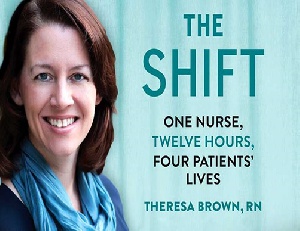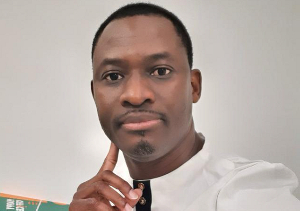“Nurses are the hospital's mechanics, its sprockets and gears” (Theresa Brown, The Shift, p. 242).
Why she left the more temperate niche of her collegiate professorship for the controlled bureaucratic chaos and turbulence of the hospital may probably come as a surprise to the casual observer who, by any stretch of the imagination, is not intimately familiar with the acute autobiographic details painstakingly outlined in “The Shift: One Nurse, Twelve Hours, Four Patients’ Lives,” a book written by Theresa Brown.
Ms. Brown holds a doctorate in English, is a former university professor of English, a brilliant writer and now a registered nurse (RN). “The Shift” provides a detailed window into her chaotic twelve-hour shift in a typical American hospital.
In other words what motivated Ms. Brown to make a radical transition from teaching in a university to working as a nurse in a hospital? She may subtly have appealed to the alluring audacious finesse and practical aesthetics of midwifery as a motivating factor in her ultimate lifetime decision (p. 190-191), after a midwife successfully assisted her while she delivered her bouncing twin girls, Miranda and Sophia, yet she never became the nurse-midwife she wanted to be. Instead, she became a bedside nurse/oncology nurse (p. 232).
Ms. Brown is therefore an interesting case study in the grudging vicissitudes and uncertainties that are so typical of life and, ultimately, of personal choices—she being also a captivating antithesis of Harvard’s Henry Louis Gates, Jr. who originally wanted to be a medical doctor but turned out a literary critic and writer instead.
Furthermore like Gates, she is acutely aware of the social and political forces that drive and shape human, societal, and official behavior. On the contrary Ms. Brown is not an establishment thinker, and as a matter of fact also not the kind of genuflecting milquetoast who sees herself as the type beholden to the grinding dictates of authoritarian officialdom, but rather as a sort of tactical and strategic maverick who puts a premium on her personal convictions, an outspoken intellectual and keen observer willing to underwrite the obituary of the status quo in the health care industry.
Ms. Brown’s narrative signature draws heavily upon a wide-ranging panorama of ideas, disciplines, literary and poetic sources, and some popular anecdotes. Of course, there is no denying the fact that many of the things she discusses in her book are familiar trending staples in nursing curriculum development and professional practice.
Use of the stethoscope and the sphygmomanometer, and of temperature-measuring instruments, weighing scales, palpation and percussion techniques, otoscopes, pulse oximeters, ophthalmoscopes, call lights, physical assessment of the skeletomusculature, obtaining subjective and objective data are all too familiar—even though she did not specifically mention a number of those let alone describe their clinical functions with assiduous attention for the lay reader.
Yet their uses and presence in intensive care units (ICUs) and hospitals such as the place she worked, and about which she passionately wrote culminating in “The Shift,” and the very nature of the emergency caseloads she and her colleagues handled, no doubt called for them. Here is what she (p. 67) says about data collection and data analysis, to name but one example:
“Smart, hard-working people gather data, ponder for however long they’ve got, and then act. Time is always of the essence.”
Her central argument (p. 67) in support of the quotation above is that “most of modern health care doesn’t consist of intense deduction followed by ‘Aha!’ moments.” And she is absolutely right. There is, therefore, not much to say about those afore-cited elements except to highlight some of the major topical discussions she brings to bear on her caustic criticism of certain facets of clinical practice in modern health care. Here she cautiously draws upon the work of physician and writer, Abraham Verghese, whose focus on the healing prowess of human touch in clinical practice also remotely—if not indirectly—serves as a well-structured critique of Atul Gawande and Peter Provonost.
Gawande and Provonost have proposed a set of rigid clinical algorithms they call “checklists,” made up of a set of procedures and protocols, namely, clinical expectations nurses and other healthcare providers are required to adhere to, for instance, in analyzing and when electronically documenting a patient’s potential fall risk.
Elsewhere she makes the thoughtful remark that electronic health records (EHR) does not make it easier on and for nurses, either. Ms. Brown then makes the case that the time she spends documenting a patient’s fall risk literally takes her away from observable instances of intimate situational assessment, usually dictated by the uncertain clinical parameters of patient engagement as well as by the questionable integrity of patient ambulatory assertiveness. She writes in that regard (p. 50):
“Designers of electronic charting systems don’t seem to understand that checklists themselves are not the innovation, because checklists are not substitutes for care. The real innovation is having staff use lists to consistently create the safest and highest-quality clinical environment possible.”
She further notes: “I would like to be encouraged to physically ‘observe’ my patients rather than simply record that I ‘have’ observed them” (p. 52, emphasis in original). This is why Verghese believes use of procedural techniques based primarily on human touch—from palpation to percussion—is a dying art in modern clinical practice. Ms. Brown’s pointedly frames (p. 134) her take on the utility, or lack thereof, of human touch in clinical practice this way:
“Nurses touch patients all the time, typically not to make diagnosis, since that’s not what we officially do, but to gather information and to help—with going to the bathroom, bathing, walking, eating, managing pain, figuring out if someone’s taking a turn for the worse. Touch connects the essential humanness of nurse and patient, reminding me that we are two people with a shared mission: healing, if we can.”
Regardless, it is striking that Ms. Brown subtly acknowledges a teachable momentum of beneficial complementarity and intellectual continuity between Verghese on the one hand, Gawande and Provonoston the other hand. This beneficial complementarity is meant to overshadow any contrastive polarity that is likely to crop up between the two blocks of public intellectuals. This is Ms. Brown again (p. 115):
“The time I spent with Sheila, her sister, and brother-in-law feels like one of the most important things I will do today, but it doesn’t show up on any of my electronic to-do lists. We need a menu that includes the option: spent time comforting patient with life-threatening diagnosis. But nothing that empathy-intense gets included in our required paperwork.”
This critical observation is important in clinical practice, as well as for professional socialization. Even more so it emphasizes the need for healthcare professionals to aim for optimal compromises in advancing the best interests of patients, as well as of empowering them—patients.
Regrettably, though, this perceived or supposed environment of optimal compromises is itself sometimes plagued or compromised by the asphyxiating weight of internal official and institutional wrangling.
Let’s preferably label this typological instantiation of internal official wrangling at the workplace as command hierarchy, hierarchy of authority, power hierarchy, or as she calls it "hierarchies of power" (p. 30) or "power trip" (p. 16). In this loose configurative framology of power structure medical doctors occupy the pinnacle of decision-making mandates, nurses follow next in line, while nurse aides or assistants, maintenance crews and so on ostensibly follow in that order of decreasing official importance.
It is quite intriguing to note that among nurses themselves the charge nurse/resource nurse, in turn, exercises enormous functional and institutional power over other nurses, the assistant nurse, and orderlies. Some RNs call their charge nurses who exercise this typology of functional power over them "charge bitch" (p. 16).The hospital where Ms. Brown worked, the focus of “The Shift,” is in effect a theatre of "Cold War."
Most significantly, perhaps, it's also worth hypothesizing that there are nuanced appearances and interplay of American social psychologists Bertram Raven’s and John French’s “Five Bases of Social Power” scattered throughout the book, with legitimate power, coercive power, expert power, and reward power possibly gaining a strong foothold in the typology of professional socialization she alludes to in the book, to the virtual exclusion of referent power.
This convenient grid of official and bureaucratic placements somehow imbues medical doctors with a false sense of entitlement that it is they, and that it is actually they alone, who are the ultimate bearers—if not the only true incarnation—of the resourceful zenith of medical knowledge. After all, there is no question that both medical knowledge and medical science constitute themselves into an ever-expanding universe of library of ideas that no one person can usefully monopolize and appropriate.
And this ever-expanding universe of library of ideas is the shared responsibility of nurses, doctors, and others since no man is an island unto himself. Here is how Ms. Brown (p. 170) describes the way power dynamics plays out at the hospital she works:
“Or perhaps as a culture we want to believe that physicians are superhuman, and some doctors want to believe that of themselves…Problem is they’re not; no one is.”
Ideally, the hegemonic centralism which the medical doctor represents in the claustrophobic topology of workplace professional socialization peripheralizes the expert decisional autonomy and presential instrumentalism of the nurse who is more likely to spend time with patients than doctors.
What cannot be ignored—given the preceding discussions—is that there is an inherent cascade of trickle-down effects from this disenabling internal official friction between nurses and doctors across the applied regimen of care strategies and priorities for patients. It is interesting how Ms. Brown has taken it upon herself to read so as to understand the organizational psychology of doctors (p. 212-213), then provocatively referring to doctors as nurses' "shadow bosses" (p. 176). Some doctors even treat nurses as servants (p. 57).
Still, the grinding tensions between and among interns, residents, fellows, and doctors add on to the mounting layers of tensions that already exist between nurses and doctors. In that regard, it will serve no useful purpose trying to deny the existing infrastructure of condescending tensions that also obtains in professional relationships linking nurses to other low-level employees such as nurse aides. She writes about this nurse-doctor tension without mincing words (p. 187): “Nurses sometimes serve as intermediaries in this way: physicians take their frustrations with each other out on the bedside nurse because we’re safer.”
Surprisingly or unsurprisingly, nurse-nurse tension is also a reality, as she notes (p. 238): “We oncology nurses and the ICU nurses don’t always get along so well…” Finally, gender politics also rears its ugly head in these environments. Ms. Brown draws upon two of Leonard Stein’s published papers, titled “The Doctor-Nurse Game (1967)” and “The Doctor-Nurse Game Revisited (1990),”to buttress her discursive arguments.
Yet, these all-too-familiar jeremiads do not even begin to take due cognizance of the fact that administration’s official and bureaucratic preoccupation with the bottom line (p. 18, 101) could potentially undermine quality care in general and patient-centered care in particular, while she equally notes that hospital administrators should “put the patient at the center and figure out money from there” (p. 19).
Neither do these jeremiads take full account of the good intentions of empowered patients, mutual suspicions between patients and nurses, and family pressure, when, in the final analysis, these occasional indeterministic variables are to be factored into the focused decisional calculus of nurses as they pertain specifically to clinical care, in the final analysis, these occasional indeterministic variables are to be factored into the focused decisional calculus of nurses as they pertain specifically to clinical care.
The potential for healthcare officials to stray from focused application of and adherence to infection control protocols, universal competencies, pain and skeletomuscular assessment techniques, obtaining and evaluating subjective and objective data, documentation procedures and protocols, teamwork and collaboration, taking vital signs, and carrying out intimate professional socialization with patients in the midst of the afore-referenced blanket official and bureaucratic contradictions—thus becomes great indeed. This may in both the short- and long-term defeat the purpose of electronic documentation. She writes (p. 13):
“Computers should make the process faster, easier, but instead of efficiency, they enforce thoroughness. We’re expected to chart almost everything, preferably in real time. Real time charting is impossible, though, in a patient needs a lot of immediate care.”
“If it isn’t charted it isn’t done,” she notes elsewhere (p. 117). Addressing the preceding concerns entail serious questions of ethics and prudent exercise of the conscience. It makes practical sense then when Ms. Brown also implies nursing is not merely about caregiving, which, in other words, admittedly, she interprets as being more than simply that.
As a matter of fact she sees nursing also as a creative function of the optimal if sagacious adjudication and application of management science, social justice, health equity, effective communication, human relations, teamwork and collaboration, time management, quality control, emotional intelligence, psychology, pharmacologic knowledge, health economics and politics, love, pursuit of task- and goal-oriented goals, law, privacy (patient confidentiality laws, p. 13) and patient-provider trust issues, informed consent and health literacy, time management, patient and nurse empowerment, medical compliance, labor laws (p. 137-138), patient engagement, leadership skills, arithmetic (p. 124), universal competencies, medication administration, health care economics, and rapid response team (RRT).
Granted, it is abundantly clear from the book, and also from the foregoing, that nursing and human caring are not necessarily innate gifts or largesse of nature, of the environment. Rather, they are learned or acquired set of skills that can be activated through a focused regime of consistent conscious practice.
That is, it is just not enough to rely exclusively on one’s intrinsic potential and resources for the sole purpose of successful professional practice. This presumptuous assertiveness of going it alone could be a symptom of misplaced confidence and, possibly, of ostentatious miscalculation of one's intrinsic capabilities.
It is rather the unfortunate case that the repercussions and implications of a nurse’s scope of practice and official responsibilities are not necessarily restricted to the perimeters of the workplace. Sometimes, and they always do in many a situation, these repercussions and implications trail healthcare professionals to their doorsteps—their homes. My point is that professional nursing practice and onsite happenings transcend the rigid parametric boundaries of the workplace (p. 244-248).
The other point is that mistakes are inevitable in clinical practice. However, this does not rule out the fact that clerical and clinical errors in clinical practice can be costly in terms of the preventable loss of human lives and body parts, and of patients incurring unnecessary permanent physical injuries and psychological scars, regardless of whether or not a nurse truly knows he or she is in violation of a procedural protocol(s) that is also the major causation of serious medical mishaps. As they say, “ignorance of law excuses no one.”
Even so professional negligence can indeed be unpardonably costly, and there is no excuse for that in the strategic calculus of clinical considerations. Strategic caution, prioritizing, nursing judgment (p. 48), recalibrating tasks, and proactive attention to detail are therefore prized commodities in the marketplace of human caring.
It is in this context that Ms. Brown emphasizes accurate measurements and calculations set against the critical backcloth of overlapping, or duplicative, oversights. What she calls (p. 37) “clinical myopia” is therefore not an option for nurses. It looks as though she has a vague understanding of game theory, the sociology of knowledge, decision theory, and critical theory. Vestiges of these basic concepts play out in the underlying architectonics of her narrative.
The above notwithstanding, is it any wonder that makeup is a luxury for female nurses (p. 9)? Ms. Brown (p. 248) is right to say nursing is “a hard job.” She (p. 9) is also right to assert that in hospitals “resilience and determination are prized as highly as empathy.” In the hospital hope and despair, life and death, bioburden and asepsis, success and failure, heaven and hell, microorganisms and human beings…harmoniously co-exist exist in a wondrous flux of managed care and decisional chaos, all mediated by how well or unwell the package insert of unforeseen and unforeseeable variables plays out in response to well-intentioned treatment and institutional protocols.
Some of these well-intentioned treatment protocols have led to unintended deaths of patients and caused harm to others (p. 64). No wonder she says (p. 5): “the hospital itself is a paradox.” Understandably if not ironically, for her the chaotic nature of the hospital environment has constituted itself into a sporadic nagging source of nostalgic yearning for the relative calmness of her university days (p. 65). This is why aspiring and even established nurses must read this book, to know what it entails to be a nurse in the American healthcare industry.
Also her acute observation that genetic luck, dumb luck, economic luck, and geographic luck, that patients should not be depersonalized—which compels her to begin her daily clinical routines by learning more about her them (p. 17), and that patient advocacy matter greatly in determining the state of health and health outcomes for patients is not out of place. They are rooted in the hard facts of social, stochastic, and political realities.
What is more, though she does not come across as an agnostic, a deist, or even an atheist for that matter, she goes to great lengths to ensure that a patient’s request for a cleric, a minister ready to deal with one of her patient’s spiritual concerns as they relate to her end-of-life questions, is duly met. Ms. Brown’s sharp critique of science in this context is also in order (p. 198):
“I myself don’t believe in miracles…It feels good to think that the love of family or friends can bring on a turn-around that science can’t explain.” Again, she notes elsewhere (p. 251-252):
“There’s genetic luck always, sometimes at a level of biochemical processes that science does not yet understand.”
In a nutshell, the book eloquently celebrates nurses and their enormous impact on the healthcare system in terms of the delivery of quality care and generally, of improving health outcomes for patients, as well as man's responsibility toward his fellow man. In the end I have to say “The Shift” has a major defect. This flaw is seen where the narrative superstructure from which the book derives its characteristic power of rhetorical essence and teachable imageries happens to be the Eurocentric model.
Ms. Brown’s formulaic poetic and literary allusions are direct artefacts of the Western literary canon, as seen from her hagiographic references to Shakespeare, E.M. Forster, William Blake, John Milton, Rudyard Kipling, John Keats, Homer, and Ernest Hemingway, all writers this reviewer has read.
Ironically the Lebanese-American Khalil Gibran, the sensational author of “The Prophet,” another book this reviewer has closely read, and the Puerto-Rican American physician-poet William Carlos Williams, make a surprising appearance in “The Shift”—only that the Western literary canon somehow artfully muffles or stifles the vocal presence of no less an influential poet and writer of the global stature of Khalil Gibran. Technically, Gibran's is the quintessential Asian voice in this impressive narrative Ms. Brown presents to the world.
On the contrary, there is no African voice in the entire narrative landscape of “The Shift.” This is deeply troubling as we strive to erect a society based on an ideological scaffolding of inclusiveness and cultural competency. The fact is that there is nothing Homer, Shakespeare, Forster, Hemingway, Milton, Kipling, Keats, and Blake have said about the human condition that Toni Morrison, Molefi Kete Asante, Wole Soyinka, Ama Ata Aidoo, Ngugi wa Thiong’o, Tsitsi Dangaremgba, Chinua Achebe, Ama Mazama, Aryee Kwei Armah, Chimamanda Ngozi Adichie, Nelson Mandela, Kofi Kissi Dompere, C.L. R. James, Martin Luther King, Jr., Ben Okri, Cheikh Anta Diop, Frantz Fanon, Aimé Césaire, Nuruddin Farah, Kwame Nkrumah, Harriet Tubman, W.E.B. Du Bois, Walter Rodney, Steve Biko, Derek Walcott, Malcolm X, Abdias do Nascimento, Marcus Garvey, and Buchi Emecheta to name a few, also have not said.
The crux of the argument is that that patina of penetrating universalism and pervasive hegemony which this Eurocentric model stands for is such that it discountenances inclusive liberalism and cultural competence, in which case we have the Western voice alone assuming a majestic state of focused centrality, universality, and idealistic indispensability in our shared experiences.
In our special case the Western literary canon becomes the ultimate triumphalist, arbitrative voice—or the only authoritative voice of reason in behalf—of humanity. Yet our natural diversities and differential experiences in the midst of our common humanity dictate otherwise.
It is therefore extremely important that we critically interrogate this tendentious, hegemonic Eurocentric model in the American academy even as we also explore other competing alternatives, built around accommodating models of inclusiveness, cultural sensitivity, political correctness, cultural and linguistic competence, and scientific objectivity.
On the other hand, this exemplary display of unconscious bias and exclusionary tacit silencing of the non-Western voice constitute a formidable internal critique of the Eurocentric model itself. As an African reading this wonderful book, “The Shift,” and like the main character of Ralph Ellison's classic novel “Invisible Man,” I did not feel or sense my presence in the narrative superstructure of Mr. Brown’s healthcare experiences, all of which I view primarily collectively as a true American story, as well as my historical and contemporary intellectual contributions to the American experiment.
Yes, I felt completely lost in or missing from this most important frosted-glass maze of Ms. Brown's exquisite narrative, as it were my historical and contemporary presence in the American body politic and continuing intellectual contributions to the stockpile of human knowledge exiled in the no-man's-land of conscious or unconscious oblivion, perhaps because the Eurocentric model has been forced to disengage itself completely from anything that has to do with the natural language of cultural appropriation and human parity in intelligential resourcefulness. And yet this unique American story is also a human story since nursing and human caring are—themselves—universal symbols of love and kindness, uncertainty, life and death, community, hope, brotherhood and sisterhood, industry, and resilience. Politics aside, it is reasonable to see nurses as either the linchpin or backbone of the healthcare industry.
But then again there is the tendency for the book’s universalized motif of stereotypical "blondness" to, as a matter of course, reinforce or induce that invidious concept of grossly misunderstood state of damning symptomatology—of inferiority complex, that is—in a potentially self-conflicted minoritized person, largely of African ancestry within the larger American geopolitical context, exactly what we eventually come to discover in Toni Morrison’s classic novel “The Bluest Eye.”
Ms. Brown's symbolic use of the words "night" and "darkness" to mean fear and death (p. 12) is a special case in point. Thus the Manichaean contrast of "night" and "darkness" with "daylight" is eloquently established for all to see—even if this sharp contrast is undeserving of any further elaborate sugarcoating. Yet she also equates "night" with "calmer" and "peaceful" (p. 12). One always wonders what Ms. Brown will have Shakespeare’s tragic hero, Othello, say about the modern-day hospital! The hospital is an intricate paradox indeed!
Indeed the intrinsic novelistic tone of “The Shift” betrays an accommodating sense of narrative nonfiction and presential audacity, which makes one wonder whether the book is not susceptible to the hazy bug of manufactured facts, even while I try so hard to uncouple Ms. Brown’s prying observations from the uncritical netherworld of alternative facts and post-truth realities. I am by these statements not questioning her integrity and eidetic memory, though. This is largely because she sounds very credible. Also, I reached this conclusion after having listened to a number of her public interviews and read some of her major eye-opening publications in “The New York Times.”
Regardless, is she ethically justifiable in making her patients part of the controversial public discourse on healthcare politics, even if she so much as conveniently chose to assign them sobriquets for reasons of privacy and anonymity? What exactly do patient confidentiality laws say about this sensitive matter? Could it also be possible she herself wrote under a pseudonym? These are serious questions for us to ponder over. Nonetheless I have no doubt in my mind that she is proud to be a nurse. She confirms this herself with the following pointed remark (p. 129):
“This is nurses’ work and it’s a privilege to do it. It’s not every day you get to give someone her life back…checking some vitals, and making sure she continues to breathe…”
No doubt this is a must-read book that should be on required reading lists for medical/health science and social work programs, in spite of my reservations about and rambling critique of it, even while I also submit that current nursing curriculum development should include formal instructional and didactic directions on nurse-doctor teamwork and collaboration which nursing and medical students are supposed to learn.
However the foregoing parenthetic remark is only natural from the point of view of the contextual calculations of a tendentious reviewer like me who, very much like Ms. Brown, also wants to appreciate this complex and mercurial world, human life, and human dignity using the same critical lens as hers to reshape his grand vision of human caring, as well as to ease human suffering in both the short- and long-term. I believe these were what Jean Watson and Florence Nightingale fundamentally stood for.
Finally, though Ms. Brown's American example is unique, it stands to reason that Ghana and Africa and the rest of the world too can benefit from her critical observations and objective criticism of the American hospital. This is not farfetched—even as she admits the following (p. 212), seemingly an indelible impression I have not been able to shake off since reading this book:
"When a patient does so much better than expected I enjoy not being needed."
References
Brown, T. (2015). The Shift: One Nurse, Twelve Hours, Four Patients’ Lives. Chapel Hill, NC: Algonquin Books. Gates, Jr., H.L. About men; a giant step. (1990, December 9). The New York Times. Retrieved from http://www.nytimes.com/1990/12/09/magazine/about-men-a-giant-step.html
Opinions of Saturday, 19 August 2017
Columnist: Francis Kwarteng



















